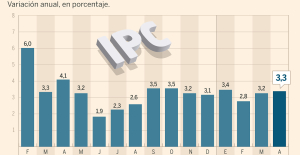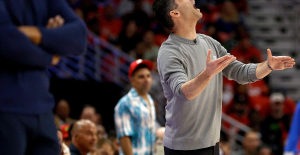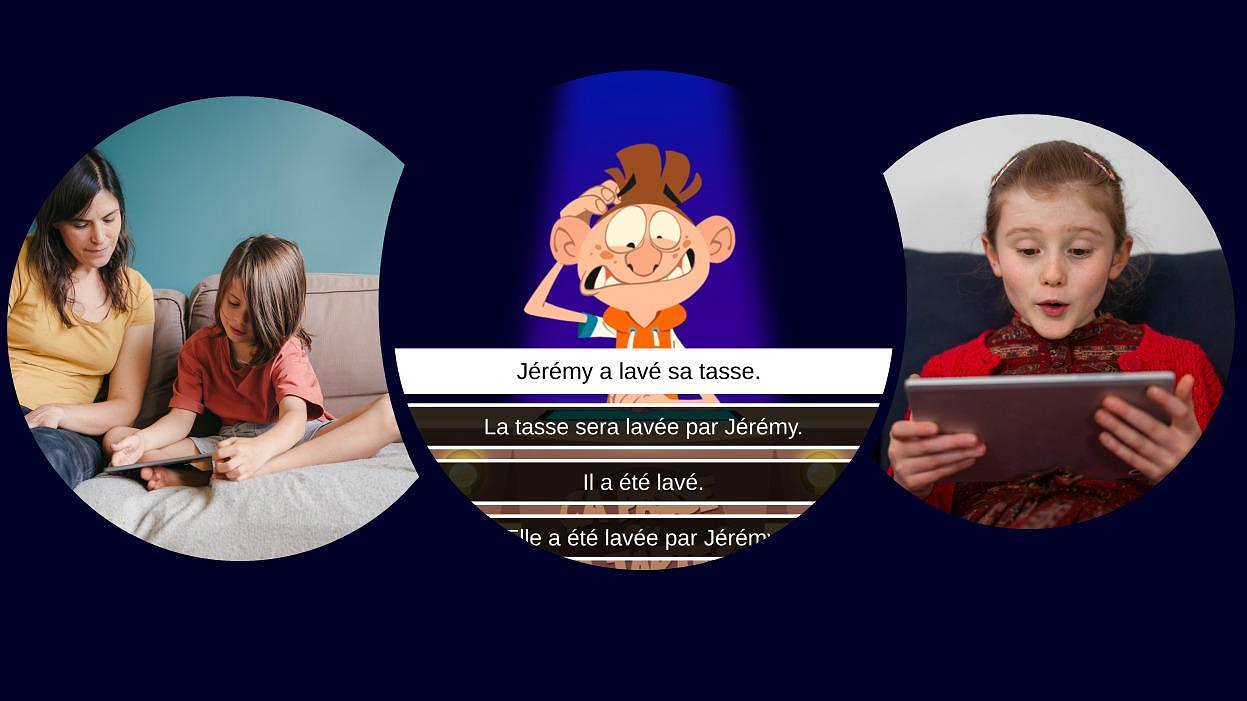Dyslexia is a learning disorder that weighs heavily on the daily school and family lives of the children concerned. Convincing them to go back to work after school can be an obstacle course for parents. So the young French start-up “Poppins” had the idea of designing a “serious” video game intended for 7-11 year olds, with which little players work on their reading, writing and coordination difficulties without actually notice it, she assures us.
Dyslexia generally reveals itself in first grade and affects 4 to 5% of children. Hearing confusions between “p” and “b”, or “t” and “d”, letter inversions by writing “fitre” instead of “frite”, difficulty reading or understanding words are some typical examples. Dr Catherine Grosmaitre from the Poppins team, neuropsychologist, head of the reference center for language and learning disorders at the Necker-Enfants Malades hospital in Paris, emphasizes that “in half of the cases, dyslexia is associated with a other disorder such as dyspraxia affecting the coordination of movements. When treated, dyslexia can fortunately improve with age.
Also read: Brain imaging reveals the secrets of dyslexia
While parents are tearing their hair out when trying to practice dictation, Poppins suggests making the child “play” his difficulties. The “serious game” (from the English serious game) has several advantages: its playful aspect, its fluid and pleasant graphics (it was designed in cooperation with Ubisoft, a big name in French video games), and a progression that takes the form of passing levels or gaining points, far from stigmatizing school grades.
As in a classic game, the player makes a small imaginary character (beaver, alien or humanoid) evolve in a colorful environment of lush forests or old ancient temples. Several programs allow children to cultivate their listening skills, sense of rhythm, writing and reading. Rhythm and coordination are, for example, worked on by shaking the tablet to make a character jump at the precise moment a third note sounds. The progression is subtle because in the first levels, a mushroom visually signals the impulse to jump. Then, in the following levels, the player will only be able to rely on his listening skills because the jumping character will be hidden by a cloud.
Emmanuelle David, teacher in Brive la Gaillarde and mother of Clément, 10 years old and dyslexic, reports, moved that “Poppins has become a daily activity at home”. “Clément progressed in a few weeks,” she said during a press conference presenting the game. “When writing, he stopped skipping letters. He segments words better, makes fewer reading errors and has become more resilient with better working memory. His school results are better: a year ago he made 27 mistakes on a prepared dictation, but two weeks ago he came home without any mistakes.” She also appreciates the digital interface associated with the game for parents which allows exchanges, video conferences, news, podcasts, etc.
To respond to parents' difficulty in finding their way in the jungle of tools offered on the internet, Poppins has had its game validated by the National Medicines Agency, in the category "digital therapy intended for the rehabilitation of specific learning disorder by a cognitive and rhythmic training. Furthermore, the effectiveness of the game will be evaluated and compared to a placebo game (which does not intend to treat dyslexia). The preliminary results are encouraging regarding the reading speed and accuracy of dyslexic children, assures the start-up. François Vonthron, its co-founder, specifies that “it takes at least 3 months to observe progress in a child.”
Still, like any video game, Poppins has its limits. Faced with the risk of screen addiction, the company recommends limiting game use to 20 minutes per day. This tool must also be used as a complementary aid to speech therapy, and not as a substitute. The application is currently available for download on smartphones and tablets (IOS and Android), for a subscription ranging from 26 to 39 euros per month depending on the duration of the commitment. The cost is partially covered by certain mutual insurance companies.
Watch the videoVideo - Dyslexia: succeeding in school despite everything

 B:SM will break its investment record this year with 62 million euros
B:SM will break its investment record this year with 62 million euros War in Ukraine: when kyiv attacks Russia with inflatable balloons loaded with explosives
War in Ukraine: when kyiv attacks Russia with inflatable balloons loaded with explosives United States: divided on the question of presidential immunity, the Supreme Court offers respite to Trump
United States: divided on the question of presidential immunity, the Supreme Court offers respite to Trump Maurizio Molinari: “the Scurati affair, a European injury”
Maurizio Molinari: “the Scurati affair, a European injury” Inflation rises to 3.3% in April and core inflation moderates to 2.9%
Inflation rises to 3.3% in April and core inflation moderates to 2.9% Pedro Sánchez announces that he continues "with more strength" as president of the Government
Pedro Sánchez announces that he continues "with more strength" as president of the Government Irritable bowel syndrome: the effectiveness of low-carbohydrate diets is confirmed
Irritable bowel syndrome: the effectiveness of low-carbohydrate diets is confirmed Beware of the three main sources of poisoning in children
Beware of the three main sources of poisoning in children Relief at Bercy: Moody’s does not sanction France
Relief at Bercy: Moody’s does not sanction France More than 10 million holders, 100 billion euros: the Retirement Savings Plan is a hit
More than 10 million holders, 100 billion euros: the Retirement Savings Plan is a hit Paris 2024 Olympic Games: the extension of line 14 will open “at the end of June”, confirms Valérie Pécresse
Paris 2024 Olympic Games: the extension of line 14 will open “at the end of June”, confirms Valérie Pécresse Failing ventilators: Philips to pay $1.1 billion after complaints in the United States
Failing ventilators: Philips to pay $1.1 billion after complaints in the United States The Cannes Film Festival welcomes Omar Sy, Eva Green and Kore-Eda to its jury
The Cannes Film Festival welcomes Omar Sy, Eva Green and Kore-Eda to its jury Prisoner in Israel, a Palestinian receives the International Prize for Arab Fiction
Prisoner in Israel, a Palestinian receives the International Prize for Arab Fiction Harvey Weinstein, the former American producer hospitalized in New York
Harvey Weinstein, the former American producer hospitalized in New York New success for Zendaya, tops the North American box office with Challengers
New success for Zendaya, tops the North American box office with Challengers Skoda Kodiaq 2024: a 'beast' plug-in hybrid SUV
Skoda Kodiaq 2024: a 'beast' plug-in hybrid SUV Tesla launches a new Model Y with 600 km of autonomy at a "more accessible price"
Tesla launches a new Model Y with 600 km of autonomy at a "more accessible price" The 10 best-selling cars in March 2024 in Spain: sales fall due to Easter
The 10 best-selling cars in March 2024 in Spain: sales fall due to Easter A private jet company buys more than 100 flying cars
A private jet company buys more than 100 flying cars This is how housing prices have changed in Spain in the last decade
This is how housing prices have changed in Spain in the last decade The home mortgage firm drops 10% in January and interest soars to 3.46%
The home mortgage firm drops 10% in January and interest soars to 3.46% The jewel of the Rocío de Nagüeles urbanization: a dream villa in Marbella
The jewel of the Rocío de Nagüeles urbanization: a dream villa in Marbella Rental prices grow by 7.3% in February: where does it go up and where does it go down?
Rental prices grow by 7.3% in February: where does it go up and where does it go down? Europeans: a senior official on the National Rally list
Europeans: a senior official on the National Rally list Blockade of Sciences Po: the right denounces a “drift”, the government charges the rebels
Blockade of Sciences Po: the right denounces a “drift”, the government charges the rebels Even on a mission for NATO, the Charles-de-Gaulle remains under French control, Lecornu responds to Mélenchon
Even on a mission for NATO, the Charles-de-Gaulle remains under French control, Lecornu responds to Mélenchon “Deadly Europe”, “economic decline”, immigration… What to remember from Emmanuel Macron’s speech at the Sorbonne
“Deadly Europe”, “economic decline”, immigration… What to remember from Emmanuel Macron’s speech at the Sorbonne These French cities that will boycott the World Cup in Qatar
These French cities that will boycott the World Cup in Qatar NBA: young Thunder coach Mark Daigneault named coach of the year
NBA: young Thunder coach Mark Daigneault named coach of the year Athletics: Noah Lyles in legs in Bermuda
Athletics: Noah Lyles in legs in Bermuda Serie A: Dumfries celebrates Inter Milan title with humiliating sign towards Hernandez
Serie A: Dumfries celebrates Inter Milan title with humiliating sign towards Hernandez Tennis: no pity for Sorribes, Swiatek is in the quarterfinals in Madrid
Tennis: no pity for Sorribes, Swiatek is in the quarterfinals in Madrid

















